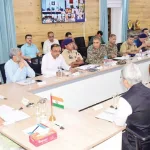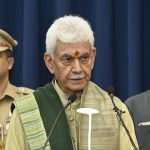Rabiya Jan is 6th class student at Government Upper Primary School (UPS) in Darcklarn, a remote village in South Kashmir’s Pulwama district. She joined the school six months ago after passing 5th standard from a primary school in neighbouring Wanchewara village.
Despite being in 6th standard, 12 year old student was struggling with basics. It was noted by her English teacher, Imtiyaz Ahmad Shah, who found her struggling hard to read letters. Similarly, she was unable to count Arabic numerals.
This issues was not only with Rabiya but also with many other students of his school.
“We have more than 210 students, 90 percent were found to have learning deficiencies,” head teacher at UPS Darcklarn, Imtiyaz Ahmad Magray said adding that the learning gaps resulted due to COVID-19 pandemic which triggered closure of schools for around 3 years hitting student’s all-round development.
“Though, online sessions were conducted forstudents during this period but they were not as effective as on campus classes,” the teachers said.
The observations by teachers at UPS Darcklarn mirrored in an Assessment Survey carried out by Jammu and Kashmir State Council of Education Research and Training in 2021 which observed that learning gaps have widened due to COVID-19 lock-down and school closure.
“In comparison to NAS (National Achievement Survey) 2017, average performance of students has declined. Primary class students have suffered more due to school closure. Differences in the learning levels among the students of a same class have increased and 57% of the students have scored less than 50% in the JKUT Assessment Survey 2021,” the survey report states.
A cursory look at the prescribed text book for English for class 6th depicts that it has been assumed that students at this level should be fluent with sentence and paragraph reading.
However, the ground situation at UPS Darcklarn was different. Barring few students, the majority were unable to read or pronounce words correctly; some were still struggling with basic language letters.
The teachers were in a dilemma whether they would go with prescribed textbooks or come up with some out of box solutions to address these learning gaps.
“Going by text would have left learning gaps unaddressed and at the end of the day we would have faced school dropouts,” the teachers said.
The expertise of Imtiyaz Ahmad Shah, who is a master trainer for National Education Policy (NEP) 2020 in Shadimarg zone, came handy.
He proposed competency based education which focuses on flexibility, personalisation, content mastery, outcomes, meaningful assessments and fast feedback among others. His proposal was accepted by the head teacher as well as his colleagues.
The implementation of competency based learning (CBL) made them to classify students from class 6th into various levels.
Similar classification was followed for mathematics in accordance with the principle of FLN (Functional Literacy and Numeracy) to make their foundational learning strong.The classification allowed students to learn at their own pace.
The teachers created such a learning environment where students applied their knowledge and skill and demonstrated their competency. The students were assessed on a daily basis for learning goals and outcomes.
Shah said that this approach helped students to overcome learning deficiencies which prompted them to replicate competency based education in all classes.
He said that a child is assessed on the basis of competency and is placed in a level suiting him or her irrespective of his or her formal grade.
For class 5th, UPS Darcklarn has three levels to bridge gaps in English language: 8 students are at comprehension, 5 at paragraph and 3 at word level.
Shah told Rising Kashmir that each level is being assigned to a skillful teacher who identifies learning gaps and develops appropriate learning modules to address them. He said that students are promoted on the basis of competency from one level to another.
He said that more than 80 percent of students were able to overcome learning deficiencies following this approach. The teachers have done away with route memorisation and encourage analytical thinking through plays, activities, quizzes, language skills and applied math.
“By session end we hope all of our students will overcome the learning deficiencies,” he said.
Dr Fayaz Ahmad, head school leadership academy in Jammu and Kashmir State Council of Educational Research and Training (SCERT) stationed at Baghat Barzulla told Rising Kashmir that they were on a visit to Kasturba Gandhi Balika Vidyalaya (KGBV) at Sangerwani village where they were informed about this school.
“This school is in our consideration and we will be collecting further information from Chief Education Officer Pulwama before documenting self- motivated interventions of teachers in addressing to contemporary challenges faced by students,” he said.
Though deficient in infrastructure, constructive engagement of students have compelled parents to admit their wards at Government Upper Primary School Darcklarn after getting them discharging from reputed private schools in the area. Since November 2021 more than 109 new admissions were registered at this institution taking total roll to 209.
“Our school has highest number of students in whole Shadimarg Education Zone,” the teachers said.
The school was established in 2003 as primary school and operated from a rented building for 7 long years till 2010. Now, the school is housed in two single storied buildings.
“We have 7 teaching rooms for 9 classes having 209 students from KG to class 8th,” the teachers said, adding that they club students of two different grades into a single room to accommodate them.
The school stands on state land. “The courtyard has been encroached by a private person by way of planting walnut trees,” the teachers said adding that they have been moving from pillar to post pleading authorities for evicting the encroachment so that they can use it for holding morning assembly there.





